The Gift of South Dakota
Subscriptions to South Dakota Magazine make great gifts!
Subscribe today — 1 year (6 issues) is just $29!
Winter Hike On Black Elk Peak
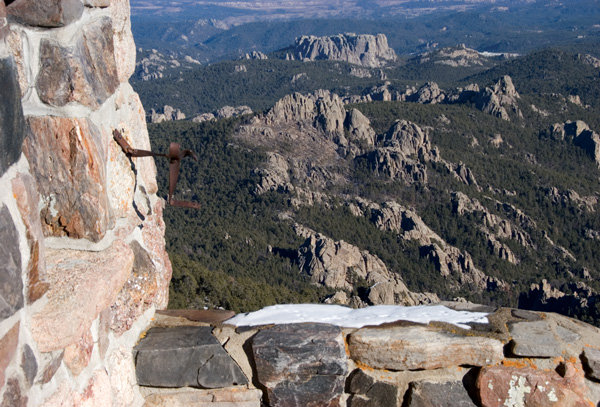 |
| Climbers who reach the summit of Black Elk Peak can gaze upon four states: South Dakota, Montana, Wyoming and Nebraska. |
Want to play like a mountain goat for a winter afternoon? Then hike to the summit of Black Peak after a soft snowfall, picking your way up the rocky, tree-strewn 3-mile trail that leads to the tallest point east of the Rockies and west of the Pyrenees in Europe. You can’t see Spain from the top, but you can easily find Montana, Wyoming and Nebraska.
I started up the trail at high noon on a sunny Sunday. At times it was dark in the deep canyons of the 7,242-foot mountain. More often, the trail led to granite-strewn overlooks so bright that I needed sunglasses to look out on the white and blue landscape.
You can hear the winter wind whispering in the pines, even on a still day. On blustery days, the wind whooshes and roars past the treetops, but down below you’re so protected by trees and canyon walls that you hardly feel a breeze.
Take a walking stick, or pick one up along the trail. A mountain goat would not think of traversing the heights of a snow-slippery mountain path on just two legs, and neither should you. A stick is like an extension of your arm; it might help you catch your balance or slow your fall. Walking uphill doesn’t seem as tricky as walking downhill, and there’s a mathematical explanation; it has something to do with the nonlinear partial differential of miles-per-hour divided by the angle squared. But leave your pencil and paper at home; you’ll understand when you step on the trail.
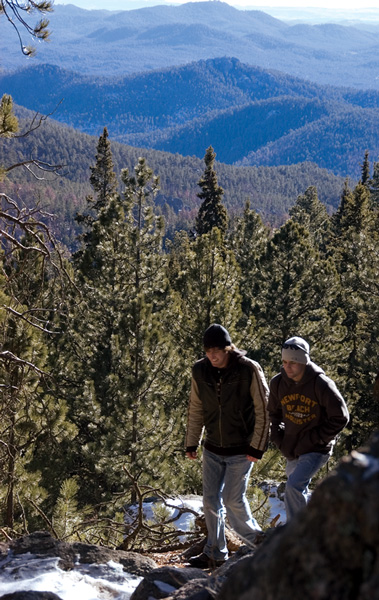 |
| Few hardy souls climb Black Elk Peak in winter, but our writer met college students Caleb Chapman (left) and Chase Merfeld near the summit. |
A stick might also give you a weapon in the very slim likelihood that you meet a mountain lion or wolf. Such encounters are almost unheard of, especially in winter. Wolves haven’t been seen on Black Elk Peak in modern times (Mount Rushmore A.D.), but a young male was hit by a car near Sturgis two years ago and another was caught in a trap in Harding County.
Dave Pickford, a ranger with the Black Hills National Forest’s Hell Canyon District, says lions have been spotted. Sightings are rare, but believable to our friends back down the mountain.
Deer, elk, turkey and mountain goats are common in the other seasons, but they winter in the meadows and thick pines at the foot of the mountain. “You might see rabbits and squirrels on a winter day,” Pickford says, “but you’re less likely to see birds and the bigger animals than in the summer.”
The lack of wildlife, along with the fact that there’ll be no motorcycles or tour buses echoing down below, adds to the solitude that winter hikers like.
Pay some attention to the signage as you go. If you’ve been known to take a wrong turn in Rapid City or Sioux Falls, then you can certainly lose your way on Black Elk Peak. I was on Trail Nine and missed a left turn on the way down; within 100 yards I saw a “3” etched in a tree, signifying Trail Three so I reversed course. If only making a U-turn was as easy on Omaha Avenue in downtown Rapid City.
After two hours on the trail, I could see the summit. But the last stretch is the most treacherous. That’s ironic because it is the most civilized. The Forest Service created smooth stone steps and a short metal stairway just below a legendary old lookout tower that was built on the summit by Civilian Conservation Corps workers in 1939.
You don’t want to fall off now, not while 7,242 feet in the air. Pickford says accidents do happen on the mountain, and he agrees that the final steps can be tricky. “We have such huge swings in temperature and weather that we tend to get a freeze-thaw effect on the steps, both at the top and all along the trail,” he says. “Especially there at the top, the steps can become windswept and they are particularly icy.”
While the wind whispers down below, it roars on the summit, especially as you climb those last steps to the observatory tower. But it’s worth the wind, even on a cold day in winter, because most of us will never see so much land with our feet on the ground.
Just before you ascend the fire tower, look for the small plate with the inscription “Valentine McGillycuddy.” It’s the name of a man who arrived in the Black Hills in 1875 as a surveyor. McGillycuddy climbed Black Elk Peak to record its height, and supposedly used a pine log as a ladder to reach the very last granite ledge. Later he became an Indian Agent on the Pine Ridge, mayor of Rapid City and dean of the School of Mines. After he died in 1939, his widow received approval to bury his ashes atop the mountain.
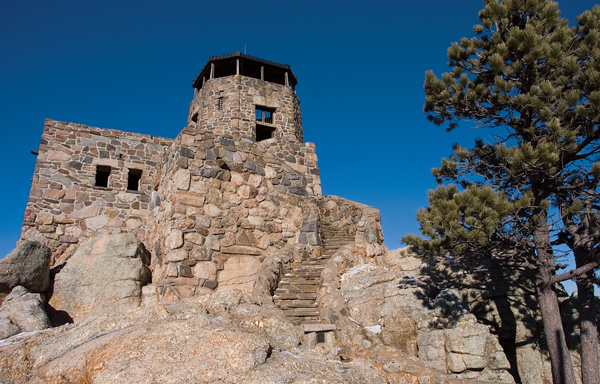 |
| Valentine McGillycuddy's ashes are interred near the top of Black Elk Peak. Surely his resting place is the highest grave east of the Rocky Mountains. |
Certain questions come to mind when you’re standing at the top. Maybe the thin air plays tricks with the mind. At first you’ll wonder why the Forest Service and Roosevelt’s CCC workers went to so much effort in 1939 to build the tower on a difficult and treacherous mountaintop. Can you really see a fire better at 7,272 feet than 7,242 feet?
You’ll also wonder why more people don’t climb the mountain in winter. Pickford reports that about 41,000 people make the journey annually; he knows, because electronic counters are hidden along the trail, and they can generally distinguish a man from a goat. But only 3,000 climbers are counted from November to March, and the number of hikers is very small in the dead of winter.
New Year’s Day is an exception, when about 200 hikers climb Black Elk. Pickford speculates that the tradition began with people who wanted to start the year with a positive activity. Eventually it became a holiday routine for some.
You might also wonder, while standing atop the Northern Plains, if widows or widowers other than Mrs. McGillycuddy have brought their ashes here, without seeking approval or disapproval from authorities, and scattered them among the granite boulders that seem more eternal and glorious than any memorial ever carved by man.
And while contemplating the eternal, you’ll wonder, while catching your breath at the top, what would happen if you began to have difficulty breathing, perhaps from a heart attack? It must be terribly embarrassing to hear your name on the evening news while you’re lying in a hospital bed: perhaps one of your children is thanking the Search and Rescue team from Custer for risking their lives to get you off the mountain, and then someone says, “We thought he was in perfect health. He eats right and exercises, but I guess he’s slipping.” It’s always wise to stay off the evening news.
But soon your thoughts are interrupted by the realization that the sun is sinking toward the western horizon. Time to descend the mountain. Carefully.
Mountain Do’s & Don’ts
We asked David Pickford, the Forest Service recreation specialist, for his advice on winter climbs up Black Elk Peak.
• Check the forecast. Even mountain goats stay off Black Elk Peak during snowstorms.
• Use sturdy footwear, and in winter consider either ice creepers or shoe chains.
• Carry along a survival kit with first aid, food, water, etc.
• Dress appropriately. Wear a synthetic liner next to your skin to keep moisture away, and dress in layers.
• Let someone know you’re going up the mountain.
• Cell phones can be helpful, but don’t depend on them at the expense of other preparations because they may not work. Many hikers prefer to leave electronic gadgets at home. It’s an ethical choice, says Pickford.
Editor’s Note: This story is revised from the January/February 2009 issue of South Dakota Magazine. To order a copy or to subscribe, call (800) 456-5117.


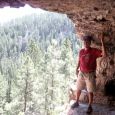
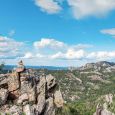
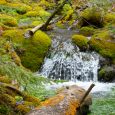
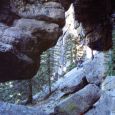
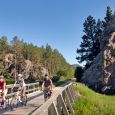
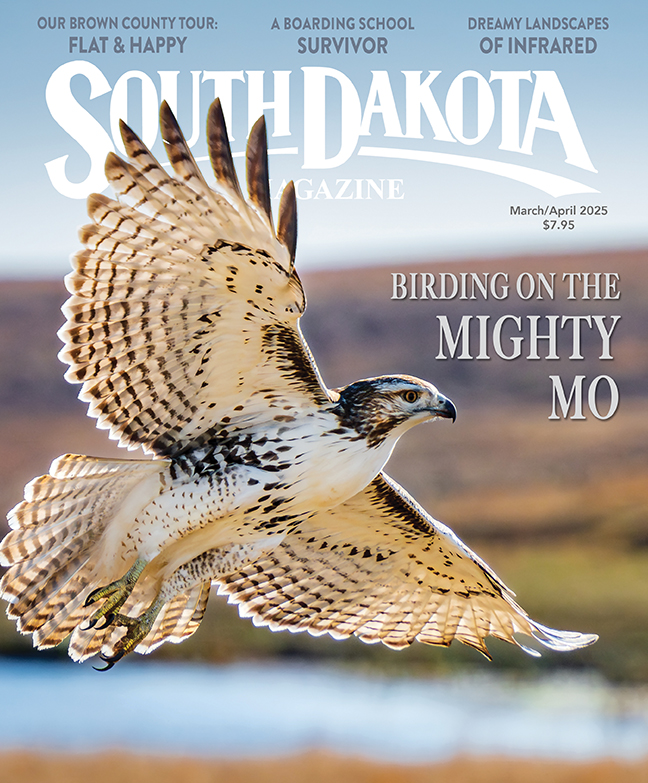

Comments
The ice curtain cover photo on the current issue of South Dakota Magazine prompted me to reach out to the magazine with another icy winter photo. Then I found this article while searching for the appropriate place to submit the photo.
The photo I took in December of 2009 can be seen on the Black Hills Facebook home page where it's received an avalanche of likes and shares, earning it front-and-center exposure:
https://www.facebook.com/blackhills
Judging by the overwhelming buzz generated by the photo I wondered if you would consider it for a future cover shot for South Dakota Magazine. BTW there's a near 10-year backstory that goes along with the photo which I welcome a chance to share as well.
Regards,
Matt Jackson
Rapid City, SD
PS I'll try to find the place on this website to submit the photo itself in case you aren't able to view the Harney Peak Tower "ice castle" image on the facebook link above.